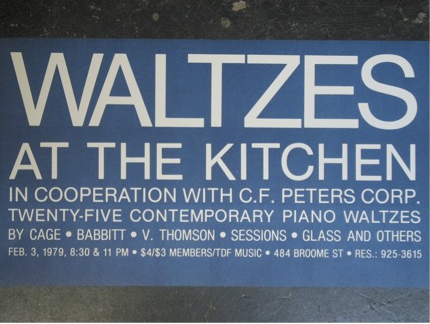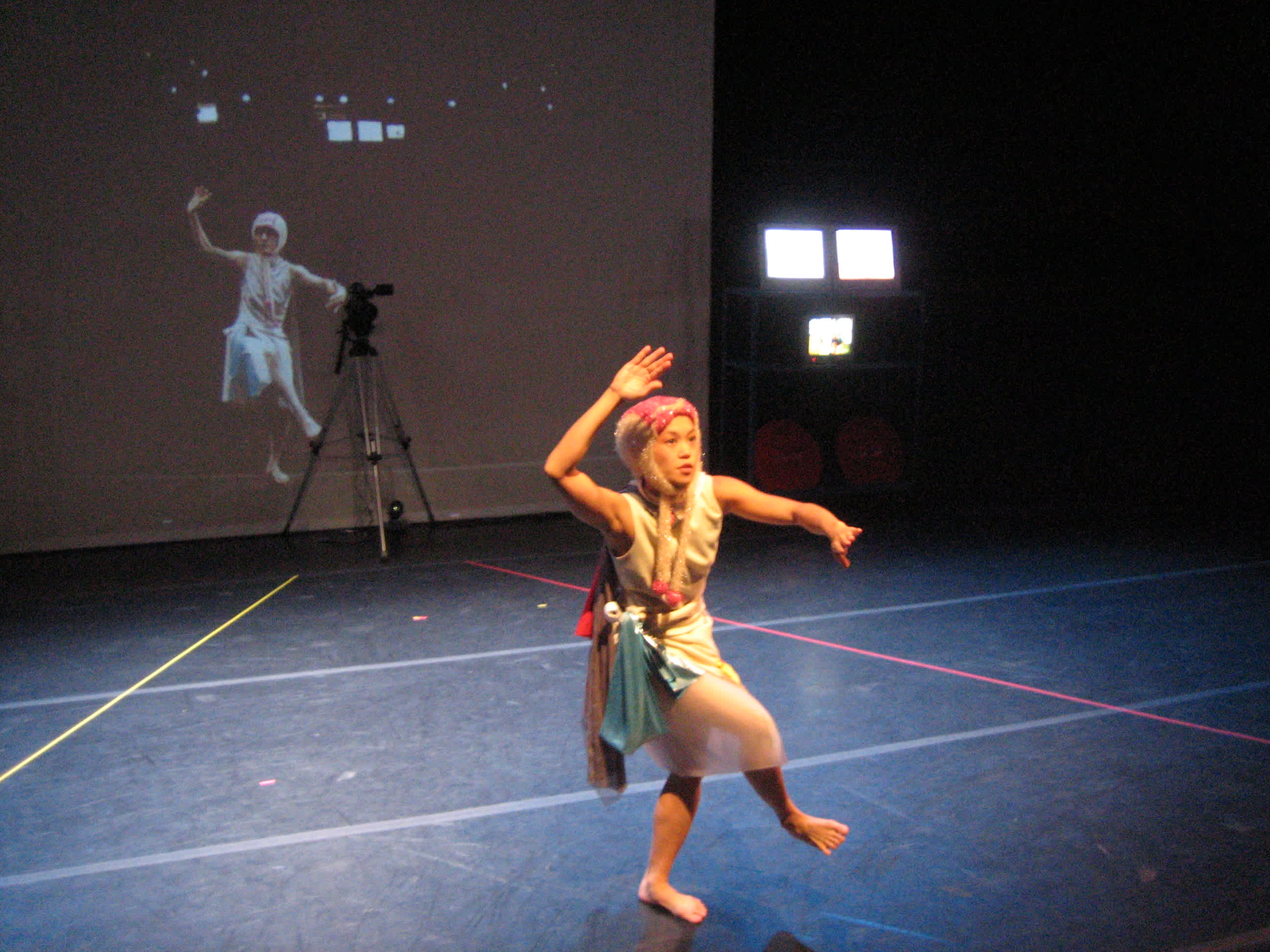
Credits:
By Diana Ryu, Winter/Spring 2020 Curatorial Intern
May 25, 2020
A WAVE OF EXCITEMENT sweeps over me when I rummage through The Kitchen’s archive. It holds a trove of events, experiments, gatherings, and ideas that do not merely dwell in the past, but also offer diverse perspectives that remain applicable today. Take for example Memoryscan, a dance performance choreographed by koosil-ja that was presented at The Kitchen in 1999. In this work, koosil-ja challenges the reductive language often ascribed to categories of race, ethnicity, and gender by focusing on individual narratives that highlight the complex cultural and sociopolitical layers of one’s self-identity. When speaking about Memoryscan in a 1999 interview with Gia Kourlas for Time Out New York, koosil-ja asked, “everyone from the US comes from another place; how do they deal with their culture and their ethnicity? How do they negotiate the terms?” Over twenty years after the performance initially took place, these questions bridging ethnic ties and cultural associations have become ever more relevant as we navigate an accelerated transnational landscape.
Last month I had the opportunity to speak with koosil-ja over Google Hangouts about Memoryscan and her broader body of work in relation to her evolving ruminations on identity. We discussed the entanglement of private and public stories that fuel personal identities, and how such histories can manifest in the form of dance. Bits and pieces from our conversation are included in the writing below.
BORN AND RAISED IN JAPAN TO KOREAN PARENTS, koosil-ja was enamored by the postmodern dance and experimental music scene of New York coming out of the Judson Dance Theater in the 1960s. She describes learning about artists such as Merce Cunningham and John Cage as “revolutionary,” especially in contrast to the commercially oriented dance training she was receiving in Japan. Moving to New York in 1981 to study dance at the Merce Cunningham School, koosil-ja engaged with dance as a medium through which conceptual and philosophical questions could be explored. Here, she was confronted with a dual pressure: “on the one hand, I had a pile of questions regarding my creative process and decisions as an artist; on the other, I had the conundrum of which country I belong to, when in the US I’m seen as an Asian woman.” These questions of being an artist, Asian, and a woman became critical points of introspection that would inform her process of cultivating her unique choreographic voice.
koosil-ja began dismantling a mono-cultural understanding of her identity through a critical examination of her ethnic lineage. As an ethnic Korean living in Japan, koosil-ja went by “Kumiko Kimoto,” a name given to her by her parents as a method of assimilation. Her upbringing—like most Korean immigrants living in Japan—was impacted significantly by deep-seated discrimination rooted in Japan’s colonial rule of Korea (1910–1945). One of her earlier works Masao (presented at Danspace Project in 1998) delved into the history of Japan’s annexation of Korea prior to World War II. In the research process, koosil-ja discovered how Korean people were involuntarily drafted and coerced to use Japanese names in order to be “eligible” to fight for the Japanese Emperor. Based on this revelation, she decided to go by “Koosil-ja Hwang”—“koosil-ja” being the Korean reading of “Kumiko” when written in Chinese characters and “Hwang” being the family name. (Now she simply goes by her first name.) Nonetheless, koosil-ja emphasizes that her decision to change her name was not merely about honoring or devaluing one cultural heritage over the other. Instead, it was motivated by her desire to be free: “I felt like leaving the Japanese name put me on a clean slate. For the Japanese, koosil-ja no longer belongs to their nationality; for Korean people, koosil-ja is not a traditional name; and for Americans, I am just an Asian, whatever name I may have. So I felt detached but also hopeful about what this feeling of alienation could bring.”
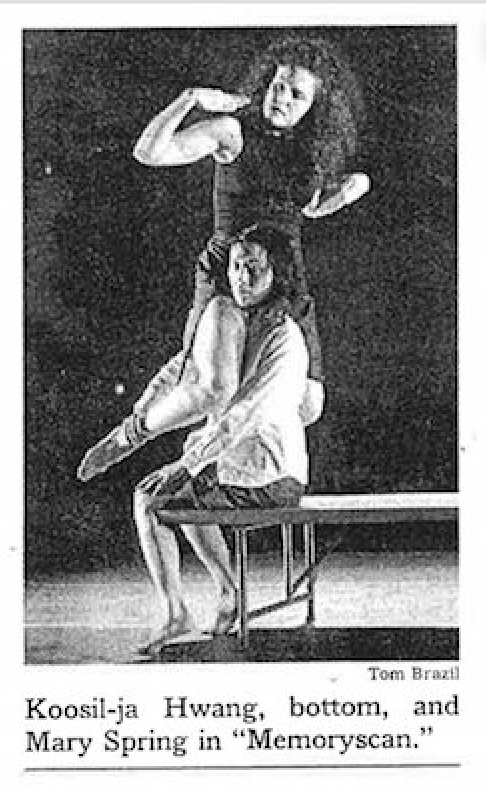
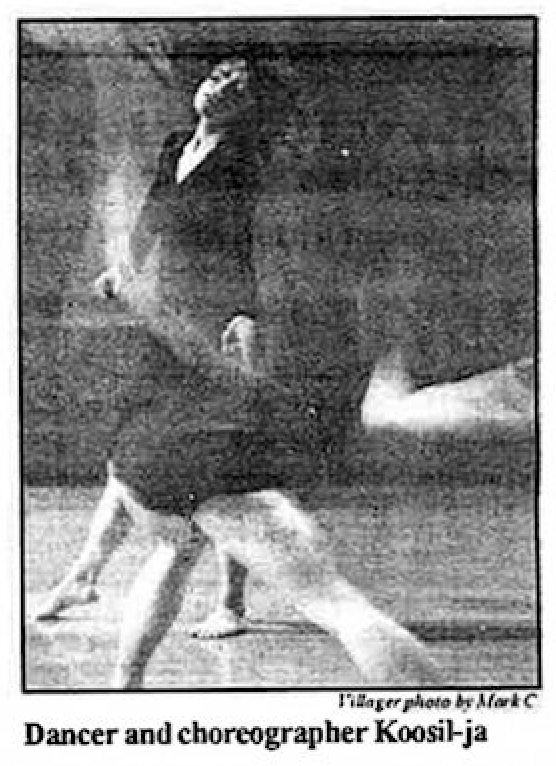
Shortly after making Masao—a piece which koosil-ja describes as very emotionally drenched— she began developing Memoryscan as a way to consider identity from diverse perspectives. She says, “I thought I was burning myself out with this unhappy history, and it made me wonder if I was the only one struggling. How about my colleagues, dancers, and collaborators? How were they dealing with their own identities? Memory became an entry point of vulnerability to each of my collaborators.”
The choreography for Memoryscan began with conversations between koosil-ja and her four dancers—Margaret Hallisey, Michael Portnoy, Kathryn Sanders, and Mary Spring—with whom she had organically developed relationships through the relatively small dance community at the time. The piece is a collage of what koosil-ja terms “tableaux of movement” based on each of the performers’ personal memories. Each tableau centers around a dancer’s chosen story, ranging from celebrity impersonation to family dinners. The choreography is accompanied by projections on the wall behind the dancers of pre-recorded footage by Caspar Stracke and visuals produced by Benton Bainbridge in live synchronization with sound. The video projection is tailored to each of the choreographic tableaux in diverse variations.
No single memory is fully explained or recounted since, according to the artist, “telling a story was not [her] intent; [she] was more concerned with creating a movement.” She continues, “I was not interested in the ‘representation’ of the memory/story, but rather in the creation of simulacrum. The gaps between the storyteller/dancer and the people in their story are the art: in the performance Sanders becomes both her grandfather and her younger self; Portnoy becomes a cow by just standing and mooing. They send the codes of who and what they are. This differs from a theater practice, as we did not deploy a psychological approach. It is all concerned with the instinct of the bodies. For me it is a dance. For the other memories, I used a method of abstraction. I filtered emotion and everything else from the memory/story to depict the people and bodies, and then maximized their kinetic relationship.”
The prioritization of movement is made evident from the beginning of the piece as the audience enters the space. In a section that serves as a prologue to Memoryscan, Portnoy stands at the center of the dance floor, tightly holding onto a rope that is tied around koosil-ja, and maneuvers her like a puppet trudging along in endless circles around the stage. This opening movement foregrounds the ethos of the work—it portrays a certain core entity around which the perimeter of a person’s identity is delineated and controlled. One of the subsequent tableaux shows koosil-ja and Spring dancing around a table, as segments of news reports in Japanese and Korean mixed with ambient sound play in the background. Spring tries to put a shirt on koosil-ja that she refuses to wear. koosil-ja recalls, “this scene was layered with the oral history passed on within my family alongside my mixed feelings of love and guilt towards my mother.” The antagonistic manner of their exchange alludes to koosil-ja’s struggles to distance herself from her mother, her family, and the colonial history of her ethnic roots.
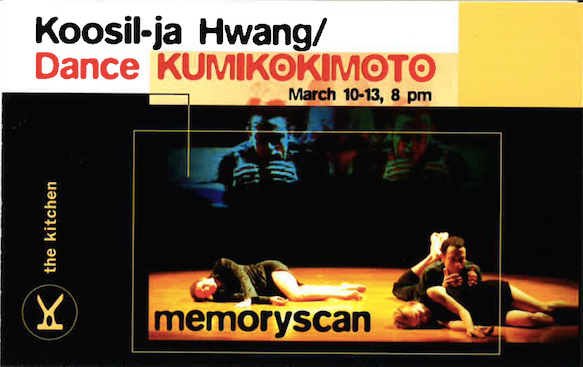
In contrast, there are tableaux that put forth a more humorous tone, such as Sanders impersonating her grandfather teaching her golf or Hallisey tap dancing as her pregnant mom. Speaking on the range of moods in the piece, koosil-ja says it became integral for her to adapt her role to be a choreographer who is “a receiver and instigator.” koosil-ja remembers that perhaps she had been “looking for [her] own familiar area of darkness” from the dancers in the beginning, but she notes that she could only request so much given that the material was to be shared with the public.
As much as the work was concerned conceptually with the translation of memories into movements, it also showcased koosil-ja’s early technical experiments incorporating video with dance. Take for example Spring’s solo tableau in which she sits in front of a screen with a projection of a scenic image of a forest. As she moves, tilting her head from side to side and down and up, the video behind mimics these movements, as if it is being recorded simultaneously with a motion detector. The synchronicity with the video extends to showing the dancer’s feet and hands playing with dry leaves in the forest as the same perspective and movement is replicated sitting on the stage of The Kitchen.
Expressing her enthusiasm for possibilities enabled by new technological advancements and commercial availability of video projectors in the 1990s, koosil-ja noted that “all my collaborators and I wanted to do was max out our credit cards and purchase a video projector… Bainbridge was drawn to the technological manipulation of sound and video, while Stracke was concerned with how the video would occupy the space architecturally. And I was thinking of video more conceptually. When memory comes out of one’s body, it is internal elements being externalized. It is like how images were taken out of the TV box and could now be projected onto a physical space—there is an extension of space and time.” (koosil-ja’s experimentation with video has continued to play an essential role in her works since Memoryscan and to develop in parallel with her expanding thoughts on identity.)
MEMORYSCAN ALLOWED SPACE FOR KOOSIL-JA AND HER DANCERS to explore identity by way of individual and familial heritage, rather than around ethnic origins. The work illuminates identity as complex, partial, contingent, and—perhaps most prominently—personal. Her exploration of identity has continued since creating that piece in the late ’90s, though she experienced a major shift in her framework for understanding identity after engaging with French philosopher Gilles Deleuze’s writings in more depth. She says:
Who I am was always a problem with me. I was looking for the answer; looking for someone to tell me who I am, what my identity is, what proper noun I should tattoo on my forehead for the rest of my life. I was looking for a perfect way to identify myself. But Deleuze rejected this concept of identity as a permanent mark on a person. For me, his philosophy was about applying time effects to our reality, meaning we are not static. The concept and instinct of “I” is not separate from the other. We are constantly overlapping with each others’ beings, and there is no singular identity. The elements that constitute who I am, my area of being, are constantly in process, shifting and changing depending on thoughts, people, views—anything I feel and see. Deleuze’s writing made the function of identity as a political and governmental agenda clear to me. So the way I was looking for the answer to identity became entirely irrelevant. And that gave me some closure to my research on identity.

The artist articulates that the influence of Deleuze’s writings on her thinking became fully realized in Dance Without Bodies (presented in 2006 at The Kitchen). Thinking about identity through Deleuze has brought clarity alongside new challenges for koosil-ja: “Later I came to realize that there is a major problem of applying Deleuze’s thoughts in relation to people from minority communities. They need to have a clear sense of identity to survive. Yet here I am. The more I delved into Western thoughts like Deleuze’s, I noticed that I was separating myself from certain struggles of minority communities. I’m trying to further unpack this now.”
TWENTY YEARS SINCE the premiere of Memoryscan, the discourse on identity has pressed forth the urgency to decolonize the racial self. koosil-ja discloses that today, she is pragmatic about the extent to which one can empathize and “share histories” with others. In her more recent works, koosil-ja has tested new ways of further problematizing the categories according to which one is identified and of re-evaluating the reduction of the body to analytical data. She continues to explore the boundless possibilities of dance and the movement of the body enmeshed with sound and video, constantly unlearning and relearning the position of the individual within society. I want to end with these words from koosil-ja that help me internalize the ever-changing flow of our time: “I want to be in the process of becoming that is the constant, generative process of being. This being is never an individual. I am incomplete without other people. I am a becoming-koosil-ja while sharing, exchanging, collaborating with them.”
